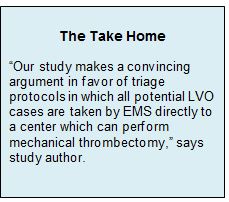Key Points:
- Study compares revascularization for LVO with, without hospital transfer
- Transfer linked with increased mortality risk

Waleed Brinjikji, MD, of the Mayo Clinic (Rochester, MN), and colleagues used both a national database and a cohort from their own institution to examine the impact of hospital transfer on patient outcomes.
First, they analyzed outcomes data from 118 institutions on 8,533 admissions for endovascular treatment of acute ischemic stroke, comparing those who were treated at the initial institution against those who were transferred to another institution for the intervention. During hospital admission, both the mortality rate and mortality index (the ratio of observed to expected mortality) were significantly lower among patients who did not undergo hospital transfer (table 1).
Table 1. Outcomes During Hospital Admission for Endovascular Treatment of LVO
|
|
No Transfer |
Transfer |
P Value |
|
Mortality Rate |
14.9% |
18.6% |
.049 |
|
Mortality Index |
1.1 |
1.6 |
.048 |
The investigators next looked at 140 patients who were directly admitted into their institution (n = 62) or transferred from another center (n = 78). For transferred patients, time to revascularization was significantly longer (420.4 vs. 277.4 min, P ≤ .0001). For these patients, traveling farther to the hospital during transfer was associated with an increasing risk of mortality (OR 1.26 per 10-mile increase, 95% CI 1.07-1.54, P = .0061).
“At our home institution,” Dr. Brinjikji told NXV in an email, “many centers which send their LVO patients to us are about 1-2 hours away by ambulance and 30-60 minutes away by helicopter. So, given the transfer times, our results were not unexpected.”
He pointed out that intravenous tPA “is not that effective at recanalizing large vessel occlusions, so we know that in many cases, even patients who are undergoing a ‘drip and ship’ protocol are experiencing additional infarct growth and neuronal loss.”
In Line With Previous Findings
Other studies have produced similar results as this one, Maxim Mokin, MD, of University of South Florida Neurosurgery (Tampa, FL), told NVX. “What distinguishes this study is that the authors' findings are based on a database of 118 hospitals,” he said in an email. “The majority of previous studies were based on single-center cohorts.”
According to Dr. Brinjikji, the “study makes a convincing argument in favor of triage protocols in which all potential LVO cases are taken by EMS directly to a center which can perform mechanical thrombectomy rather than to smaller hospitals which are not capable of providing such services.
“Our results also suggest that more needs to be done to decrease any delays in triage for patients who do end up at nonendovascular ready centers, so that they can be transferred as rapidly as possible,” he noted.
Dr. Mokin agrees. “What we are missing,” he said, “is an agreement on how to best determine which stroke patients should be directly transferred to stroke centers capable of performing 24/7 [intra-arterial] stroke interventions. There is great variability in stroke assessment scales and practices, at both local and state levels.”
Management of stroke patients could be modeled after interventional cardiology, he proposed, where there is similarly strong evidence in support of rapid allocation of patients to the cath lab. Multiple sets of guidelines are in place to facilitate identification and rapid allocation of STEMI patients. Similar systems for identifying and allocating LVO patients could be beneficial.
Source:
Rinaldo L, Brinjikji W, McCutcheon BA, et al. Hospital transfer associated with increased mortality after endovascular revascularization for acute ischemic stroke. J NeuroInterv Surg. 2016;Epub ahead of print.
Disclosures:
Drs. Brinjikji and Mokin report no relevant conflicts of interest.

